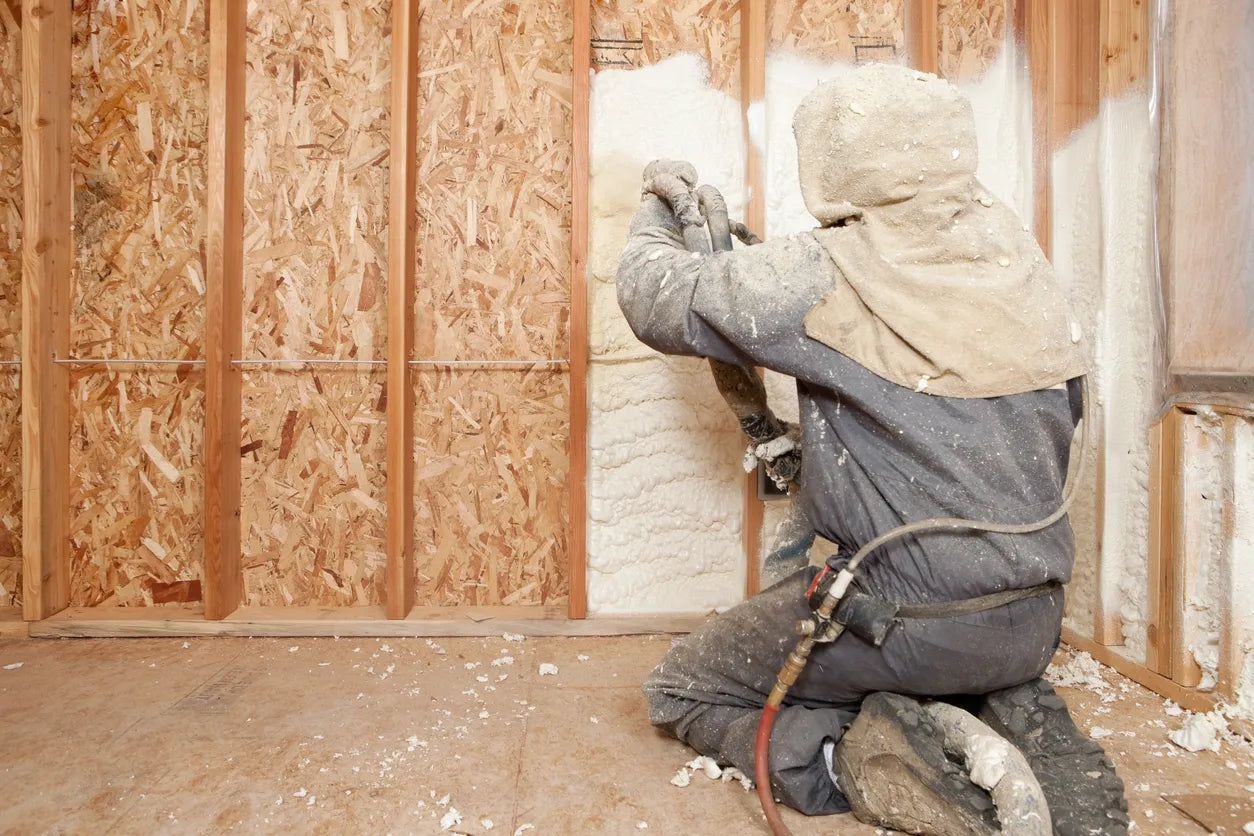Know Before You Spray: Where should you not use spray foam?
Spray foam insulation is great for making your home more efficient and comfortable. But it could be better for some space. It can cause problems like trapping moisture, making areas too hot, and voiding warranties if used wrong. So, it's best to have pros like the experts at VB Insulation install it properly.

Key Takeaways
- Spray foam insulation should be avoided in ventilated attics due to potential moisture issues.
- Using spray foam over the knob and tube wiring can lead to overheating and fire hazards.
- Spray foam poses a fire risk around recessed lighting fixtures that are not rated for insulation contact.
- Applying spray foam directly on the roof deck can cause issues with roof warranties and leak detection.
- Spray foam around plumbing fixtures can complicate future leak repairs.
Understanding the Limitations of Spray Foam Insulation
Spray foam insulation is great for making your place more energy-efficient and cozy. It keeps the cold out and the warm in. But it could be better in some situations. Knowing where to use it is key to getting the most benefits.
Versatility and Benefits of Spray Foam
Spray foam is amazing for sealing gaps and keeping your home comfy all year. It gets into every nook and cranny, forming a tight seal. This helps use less energy and save money on heating and cooling.
Read More: Benefits of Spray Foam Insulation
Areas and Scenarios to Avoid Spray Foam
Only some places are suitable fit for spray foam. Attics that need airflow, old houses, areas, and near electrical wires are no-go Spray foam. They may cause more harm than good, so it's important to know when to use something else.
Importance of Professional Application
Using spray foam isn't only for some. You need an expert to apply it right. Pros, like those from VB Insulation, know exactly what to do. They'll make sure you get the benefits without the risks.

Maintaining Proper Air Flow
Ventilated attics need air to flow freely. Spray foam can stop this, which is a big issue. The 2015 IRC says spray foam should touch the roof sheathing. This stops the attic from getting proper air, causing many problems.
Potential Moisture Issues
Spray foam can block airflow in ventilated attics and bring moisture trouble. Without air movement, moisture can lead to mold and other issues. Keeping your attic's ventilation system working well means avoiding spray foam.

Spray Foam and Older Homes: Exercise Caution.
Using spray foam insulation in older homes needs caution. These houses might have materials that are not suitable for spray foam chemicals. This could cause issues like material disintegration or bad reactions. It's wise to get a pro's assessment first. They can check if using spray foam insulation is safe for your home.
Material Compatibility Concerns
Older homes often have materials that don't mix well with spray foam chemicals. This mix-match can harm your house's parts or cause other issues. It's important to deal with these material concerns to avoid trouble later.
Professional Evaluation Recommended
An expert should examine older homes for potential problems with spray foam insulation. After a skilled contractor, like those at VB Insulation, reviews your materials, I'll tell you that spray foam or another insulation is better.
Read More: Cost of Spray Foam Insulation
Electrical Hazards: Steer Clear of Wiring and Outlets
Be careful with spray foam near electrical wiring and outlets. Bad use of spray foam here can lead to fires and other dangers.
Knob and Tube Wiring Considerations
Don't put spray foam over knob and tube wiring in old houses. The foam might make the wires too hot, causing potentially dangerous problems. For safety, avoid using spray foam in areas with this wiring.
Fire Risks with Recessed Lighting
Don't use spray foam near recessed lights if they're okay with it. If not, it could catch fire. Always check if your lights can touch the foam before adding it.
Roofing Applications: Proceed with Caution
Using spray foam insulation on a roof can be risky, and experts usually say no. Putting spray foam directly on the roof can lead to problems with warranties, as the type of spray foam used might not match the roofing materials or the warranty.
Potential Roof Warranty Conflicts
If you plan to get a loan, some mortgage companies won't lend on houses with sprayed foam roofs. They think it decreases a home's value. This is key for homeowners who want to add spray foam insulation to their roofs.
Leak Detection Challenges
Putting spray foam on a roof can hide leaks, making it hard to find them later. The foam blocks easy access to the roof, making finding leak sources tough, which can delay needed repairs.
When done wrong, spray foam insulation might trap moisture in the roof, causing several problems. It can lead to condensation, timber rot, mold, and even rust. This can damage the structure and make it hard for experts to check the house.
Taking off spray foam is difficult and expensive, and special tools and knowledge are needed. Before choosing spray foam for your roof, talk to experts like those at VB Insulation. They can guide you to the best results.
Read More: Is spray foam insulation a good idea?
Moisture-Prone Areas: Avoiding Future Headaches
Spray foam insulation in spots with big water leaks near plumbing fixtures needs extra care. It makes finding and fixing leaks hard. This can lead to moisture issues and more problems later on.
Plumbing Fixture Surroundings
In places where water leaks happen, using spray foam insulation is risky. It can hide leaks, making finding and fixing them later tough. It's better to pick another insulation solution that makes finding leaks easier. This way, problems can be fixed fast and well.
Facilitating Leak Repairs
Choosing different insulation materials for wet areas helps a lot. It means leaks can be spotted and fixed quickly. This keeps moisture damage and big problems away. So, homeowners can keep their homes safe without much worry.
Risks of Improper Application
Spray foam insulation can seal tightly, but it might cause problems if not applied correctly. Incorrect use or application can lock moisture inside, leading to mold growth and damage to the building's materials.
Moisture Trapping and Mold Growth
Improper application can trap moisture. This happens when the foam acts as a barrier, stopping air from moving freely. When moisture stays, it creates a perfect place for mold to grow. This mold can weaken the building and be harmful to people's health.
Overheating and Fire Hazards
Spray foam used incorrectly near electrical wires or lights can be very dangerous. These materials can get too hot and start a fire, which can damage the property and harm those inside.
Voided Warranties and Reduced Resale Value
Putting spray foam in the wrong spots can cancel warranties on items like roofs or appliances. This wrong use can also lower a home's value when it's up for sale. Homeowners need to ensure they use spray foam correctly. This helps to avoid these problems.
Conclusion
Spray foam insulation works great in many places but has some limits, too. It's best to let pros, like VB Insulation, guide you. They can choose the right spots for spray foam and use it well. This way, you get the most out of it with less worry about risks.
Knowing where not to use spray foam is key. It shouldn't be used in places like ventilated attics and around old homes shouldn't. Also, areas with electrical wiring should avoid it. Making these smart choices helps you fully benefit from the latest insulation tech.
Deciding on spray foam takes thought based on your home's needs and specifics. With VB Insulation's help, things are easier. They guide you, making sure spray foam brings you savings, cuts down on emissions, and boosts your building's efficiency for the long term.
FAQ
Where should you not use spray foam insulation?
Avoid using spray foam insulation in some areas. This includes ventilated attics and around electrical wiring. It's also not good for older homes if the materials might react badly to the foam. Always hire skilled experts to apply it correctly.
Why is it not recommended to use spray foam in ventilated attics?
Spray foam can stop air flow in ventilated attics. This lack of air movement can cause moisture and mold problems. So, it's better not to use spray foam there.
What are the concerns with using spray foam in older homes?
The issue with older homes is their materials. Some materials need to be mixed better with spray foam chemicals. A professional should check if it's safe to add foam to your home.
Why should spray foam be avoided around electrical wiring and outlets?
Put spray foam and electrical stuff. Don't mix. Spray foam can be a fire hazard if it touches certain electrical parts, so don't use it near them.
What are the concerns with using spray foam on roofs?
Using spray foam on roofs might breach the warranty. It could also hide leaks, making them hard to find and fix later.
Why should spray foam be avoided in areas prone to water leaks?
For places where water can seep in, like around plumbing, avoid spray foam. It hides leaks, making them tough to repair. This can lead to more moisture problems over time.
What are the risks of improper spray foam application?
Applying spray foam the wrong way can result in many risks, including mold, overheating, and fire hazards. It can also cancel warranties on your home's devices or materials. Always choose experts to apply spray foam.




